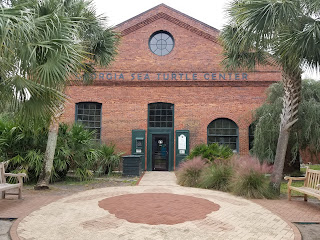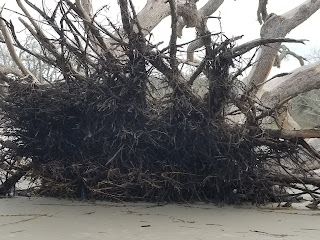#79 The Golden Isles...Jekyll Island
We ventured further south toward the little town of
Brunswick, Georgia.
Docks on stilts jut out into the waterway to provide access to the waterways in the grass.
Brunswick sits on the mainland and becomes a gateway to
the Golden Isles. Jekyll Island makes up
one part of the Golden Isles.
First we stopped at Great Dunes beach. The reference to “Great” dunes is relative to
your experience. The "Great Dunes" reside
in Colorado and on the Oregon coast.
The idea that the tide can cover these dunes up to 10
feet was interesting.
The guys, of course, walked the beach trail from one
viewpoint to the pavilion.
The park on the back side of the dunes lies covered with
thick plush grass. Very pretty!
The historic area contains many beautiful old homes. This
is one.
The Georgia Sea Turtle Center came up next on the
day. The bricks to the door show the
support that the center.
The Georgia coast which is less than 100 miles long and
made up of barrier islands boasts that of the 7 species of marine turtles in
the world, 5 of those species nest and migrate to local waters. The Georgia Sea
Turtle Center in only one of a few “turtle” hospitals in the country.
For a specie that has existed for at least 250 million
years since the time of dinosaurs, it is sad to see them threatened.
Meet Dori! She is
a survivor of Hurricane Dorian. She was
ran over by a car which flattened the top of her shell and opened a large crack
near the front of the shell. Here a team
of medical people and a couple observers are changing her dressing and checking
her recovery. The yellow stuff shows the crack in her shell. They are using
laser treatment for her too. This room has a window that opens into the
museum. She is a “keystone
species”. We will hear that later with
the alligators too. Because the dig
holes, the holes fill with water and provide nutrients for other aquatic life
during the dry season. They are a
keystone critter because without them many other species would vanish.
The five Sea Turtle Species of the area hang from the
ceiling. The Leatherback turtle grows to 6-7.2 feet long and can weigh about 1500 pounds.
The five species of turtles here include: Hawksbill,
Kemp’s Ridley, Leatherback, Green and Loggerhead.
We saw similar signs on the beach and in our campground
rules, especially about not using flashlights or taking dogs to the beach at
night. Loggerheads become mature about
30-35 years old. They return to the same stretch of beach where they were born
to mate and nest. Only the female will
return to land and lay 4 or 5 clutches of leathery eggs during a two-week
interval.
I found this interesting about turtles, and later found
the same is true for alligators. The temperature of the nest determines the
sex. Eggs around the center of the nest that are warmed by the surrounding eggs
are more likely to be female. Cooler
temperatures like the outer areas of the nest produce more males. Eggs are laid on land, but sea turtles can
swim for years in the ocean. Current studies show than only one in every 4,000
hatchlings will live the decade it takes to become an adult of reproductive
age.
This outdoor exercise area allows turtles who can’t go in
the water, like Dori, to get some exercise.
The hospital area of the center allows visitors. The last time we were here most tanks had
patients. Today just a few…. which is a good thing.
Meet Tsunami! He
appeared to be wanting out of this tank.
His injuries include severe skull and jaw fractures and left flipper wounds from
a boat strike. He has been here since
2017.
Each turtle patient sheet can be viewed to learn more
about why they are here.
Meet Glitter Mittens.
A bit of a disclaimer. I think I
have matched the turtles in the tank with their correct name.
Meet Quasimodo. He
has that distinctive scar on his shell.
The ultimate goal of the center remains to help the
turtles return to the sea. As you can see in the photo they are usually
returned with a tracking device to help scientist learn more about them.
Next stop the wharf! We booked a boat tour to see dolphins.
We did see a couple of fins, but this tour held a different agenda. And, I had
never been on a pontoon boat before.
A group high school kids were on board and here for an
educational experience. Boy did we learn a lot!
Pablo, a retired state trooper, now biologist minded held the
information.
As we passed under a bridge on our water to the
Intracoastal Waterway these birds were holding a preening party! They were as close as they appear in the photo.
This marina fills up with winters snowbirds this time of
year.
The hands threw a net into the water and let it drag
bottom for about ten minutes.
Then had the kids help pull it up. Some were more enthused than others.
Then Pablo made sure nothing dangerous was in the catch
and separated species into little tubs.
The net picked these Atlantic Shrimp, the kind you may
find tasty! Georgia shrimp are touted to
be the best, just a little sweeter. The reason is the they nest in the sawgrass
marshes.
They say the sawgrass (which isn't really a grass) is related to sugar cane and full of nutrients for those animals that shelter in its marches. Thus
makes Georgia shrimp sweeter than other shrimp.
This little guy is a squid. The long protrusion makes him male. Don’t remember what he said about the squid.
The Mantis Shrimp have been around since before
dinosaurs. The name Mantis comes from
their front feet that fold just like a Praying Mantis insect.
The Croaker Fish actually croaks! Air builds up inside and it expels a croak.
We were able to hear it when it was close to our ears.
This is a Summer Flounder.
I think this is the Southern Flounder. My apologies to true fisher people if I didn't get these correct.
This is your Tongue Flounder top and bottom sides.
The flounder on the top has the name of Hog checker. No idea why. Apparently, they are very tasty.
The flounder on the bottom is the Oscillating Flounder if I have everyone
matched correctly. Who knew there were a zillion kinds of flounder? Well, maybe a fisherman.
We had a rare treat when the White Pelicans were
spotted. Mostly Brown Pelicans hang out
in this part of the country.
Just us after the boat ride. We took a crew member’s recommendation and
went to Zachry’s for lunch. Just OK.
Off to Driftwood Beach. Someone said it was a “must see”
and they were right! After walking a
trail with these moss-laden trees we arrived at the beach.
Seeing all the driftwood like this definitely took our
breath away.
Shells littered parts of the beach. Also saw this horseshoe crab, which is not a
crab but an arthropod that lives in marine and brackish areas.
Each driftwood tree seemed more impressive than the last. Products of years of erosion, you feel like you have entered a very different world.
As you look beyond the driftwood, the colored hulk in the
background is the bottom of a cargo ship that tipped over in the bay by St.
Simon.
We ran out of time to see the museum and the historic
houses. One of the few stops where
another day would have been nice. However, Derrille and I had seen the historic
neighborhood before and all of us have seen other houses of this era.
The walk back to the car showed some of the trees perhaps
destined to become driftwood.
What a wonderful
day on Jekyll Island!!!
Tomorrow St. Simon Island









































































































No comments:
Post a Comment